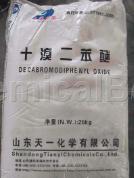Overview[1]
Polybrominated diphenyl ethers can be widely used as flame retardants for synthetic resins, fibers and rubber. Polybrominated Diphenyl Ethers (PBDEs) are a series of aromatic compounds containing bromine atoms. Depending on the number and position of bromine atoms on the benzene ring, there are a total of 209 kinds of polybrominated diphenyl ethers. conformation. Due to its unique structural properties, polybrominated diphenyl ethers are most commonly used as flame retardants and added to composite materials. At present, PBDEs have been widely used in commercial products such as electronic and electrical equipment, automatic control equipment, building materials and textiles.

Detection method[2]
A method for detecting trace amounts of polybrominated diphenyl ether compounds in the atmosphere, the method includes the following steps:
①Adsorb the sample into the sampling tube, which is filled with activated carbon;
②Sampling tube obtained from 220℃ desorption step ①;
③Pour the desorbed gas obtained in step ② into the water repeatedly;
④ Extract the solution obtained in step ③ three times with equal volumes of ethyl acetate and then concentrate to 1/9 of the original volume;
⑤ Gas chromatography detection step ④ obtained extraction phase.
Preparation[1]
CN86103093 reports a method of passing chlorine gas through excess liquid bromine to generate a bromine solution of BrCl, and then directly adding diphenyl ether dropwise thereto to brominate it. There is no need to worry about side reactions of solvent bromination, nor does it need to recover refined solvents, thereby achieving the purpose of accelerating bromination, saving bromine consumption, and reducing costs. Moreover, the method of the present invention is simple to operate and easy to master. The polybrominated diphenyl ether prepared by the method of the present invention can be widely used as a flame retardant for synthetic resins, fibers and rubber. Examples are as follows:
Add 120ml of liquid bromine and 3g of AlCl3 into a 500ml three-necked flask with stirring, and add 40g of chlorine gas within 0.5 hours at 0 to 8°C to generate bromine containing about 30% BrCl. solution, and then add 17g of diphenyl ether dropwise to the solution at 8°C (within 1.5 to 2 hours). Then the temperature was raised to 40°C, 30.5g of AlCl was added to continue the reaction for 2 hours, 200ml of water was added, the bromine was evaporated, and the precipitate was cooled, filtered, and dried to obtain 94.1g of crude decabromodiphenyl ether, with a yield of 98%. The total bromine content in the finished product 83.2%, melting point 302℃, bromine consumption 1.51T/1T product.
Degradation method[3]
Polybrominated diphenyl ethers (PBDEs), as an important additive flame retardant, are widely used in various industries, such as plastics, electronic appliances, furniture, interior decoration, transportation, petroleum and mining. Due to large-scale production and use, it has been detected in various environmental media. Among the 209 homologues of PBDEs, low-brominated polybrominated diphenyl ethers such as tetrabromodiphenyl ether (mainly containing BDE47) and pentabromodiphenyl ether have high lipophilicity, low water solubility, persistence, low vapor pressure, and can be transported along the The food chain amplifies step by step, and BDE 47 is a type of polybrominated diphenyl ethers (PBDEs) that is commonly detected in the environment and is highly biologically toxic. Research shows that PBDEs are widely distributed in different environmental media such as soil, water, sediment, atmosphere and various human biological samples around the world, and the content is on the rise. A large number of studies have shown that PBDEs pose a great threat to human health and the ecological environment due to their neurotoxicity, endocrine system disruption, reproductive and developmental toxicity, immunotoxicity, and carcinogenic toxicity. Therefore, it is necessary to continue to conduct in-depth research on PBDEs degradation technology.
CN201811373064.0 provides a BDE 47-degrading strain Citrobacter sp.ZYD-1, which was deposited in the General Microbiology Center of China Committee for the Collection of Microbial Cultures (Beijing) on November 2, 2018. No. 3, No. 1, Beichen West Road, Chaoyang District, Institute of Microbiology, Chinese Academy of Sciences), collection number CGMCC No. 16678, recommended classification name Citrobacter sp. The strain is a gram-negative bacterium, white, with gray-white opaque round colonies raised on the surface. Under the scanning electron microscope, it is rod-shaped, with a diameter of 0.5-0.7μm×1-2μm. The Citrobacter bacteria has good degradation ability for BDE47. Through degradation experiments, it was found that under anaerobic conditions at 30°C, the initial concentration of BDE 47 was 500 μg/L, and the degradation rate of BDE 47 reached 53.10% in 21 days; Under aerobic conditions at 30°C, the initial concentration of BDE 47 is 500 μg/L, and the effect on BDE in 15 days isThe degradation rate of 47 reached 48.49%. And BDE 28 was detected in degradation products under both aerobic and anaerobic conditions. Under aerobic conditions, iron ions, nitrate and sulfate were selected as external electron donors during the degradation process. The degradation rates of BDE 47 were significantly improved, reaching 53.27%, 55.02% and 58.92% respectively.
Main reference materials
[1] [Invented in China] CN86103093 Manufacturing method of polybrominated diphenyl ethers
[2] [Invented in China] CN201310538499.7 A method for detecting trace amounts of polybrominated diphenyl ether compounds in the atmosphere
[3] [China invention, China invention authorization] CN200910214489.1 Method for separating polybrominated diphenyl ethers from waste electronic plastics

 微信扫一扫打赏
微信扫一扫打赏

